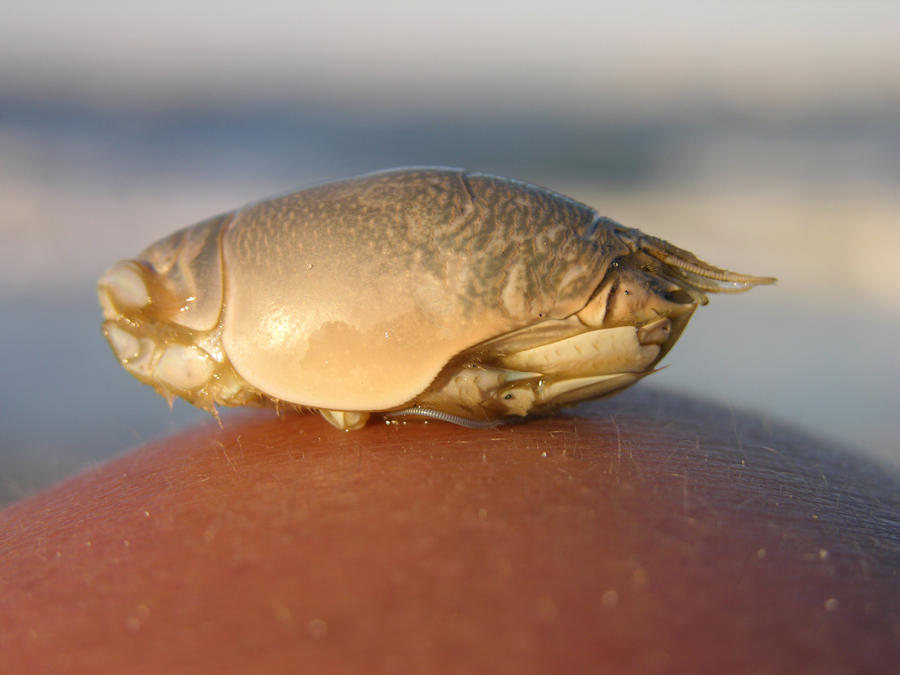The deûlémain know them as dire moles, but most of the world calls them emeridae. They live amongst most of the beaches on the cracked continent and are a piecemeal menace to its inhabitants.
Emeridae are distantly related to giant crabs, lacking their cousins' pincers or widened stance in exchange for a hard, barrel-shaped carapace. Their limbs are long, hooked appendages which lock loosely into position underneath their bodies, allowing them to glide effortlessly across rushing sand or tides. An emeridae's eyes consist of a half-dozen black sprouts. A bundle rests on each side of the head, which projects through a thin hole bored on each flank. This peeking only occurs when submerged, preferring to otherwise keep their antennae safely within their shells.
An emeridae possesses twenty-two limbs of various sizes, most of which are specialized in digging through soft sediments. Using several shoehorn-like tools at the ends of their stems, they're capable of scooping considerable amounts of material from underneath. This allows entire packs to drop below the beach floor in just a second. They are slow creatures (no quicker than a moderately excited pig), but their movement potential increases exponentially once below ground.
Emeridae are Imps. There are many different kinds of imp — the majority of which being non-aware subspecies — that exist in discordant harmony throughout the realms. Many subspecies become cattle stock or mounts for various organizations, while others remain suitable as labourers within imp colonies. Imps have a word to distinguish these labour-beasts from other impkin ('Svnth' like Synth), a distinction most other cultures lack.
They are conscious but not intelligent. Imps possess a limited line of communication with them, which boils down to a limited form of speak with animals. Negotiating with an emeridae often revolves around the basic understanding of "leave us alone, and we'll leave you alone." They have no need for treasure but collect it in troves, both for clueless bedding and as a ribbon to bargain with. Emeridae dens lie several feet beneath the beach floor, massive dugout rooms held wide by whatever trash or treasure they manage to scavenge from adventurers.
Emeridae Den Loot
1. A dead adventurer (50% still wearing their equipment).
2. 350sp in various coinage.
3. A half-eaten giant tuna.
4. A mage's lost robes.
5. Forgotten crates from a shipwreck.
6. A dead emeridae (25% of being female, holding eggs).
 |
| Don't mess with a mother and her children. |
An emeridae has no concerns for the nature of its surroundings. All it wishes to do is live beneath its rocky beaches or sandy shores, utterly free of interruption, until the day its eggs hatch and it dies. They do not go out of their way to fight trespassers, often too busy hunting fish from the sands beneath the deep tide. This does not make them ambivalent. Those in a pack who are not spent hunting or digging their burrows will violently undermine those who step atop their grounds. Hunters of the emeridae's shells or eggs will oft find themselves sucked beneath the beach by the imp's talons. What limbs aren't tipped in scooping horns are adorned in frills and spikes.
The imps can clamber to the topmost layer of sediment, grab a fully-grown man with their claws, and then fall back beneath the sands in just over a second. They move through sand like water, grasp flesh like velcro. They do not consume human flesh, but their corpses still litter the burrows.
Beyond their own flesh and eggs, emeridae are considered valuable for their carapace, which possesses impressive durability while maintaining buoyancy. Witches will occasionally travel to beach burrows to dig for eggs, then used for alchemical purposes or bred as pets. A domestic emeridae provides an excellent familiar, serving as guard and breeding stock.
Emeridae can "coast" with the ocean tides, digging up to the surface whenever the waves wash or recede. This natural movement allows entire colonies to scurry from point to point. Sailors watch for Emeridae movements, tracking their round bodies flying down the beach as a sign of nearby fishing grounds.
Imagine this but faster, larger, and with a lot more barbs.


No comments:
Post a Comment